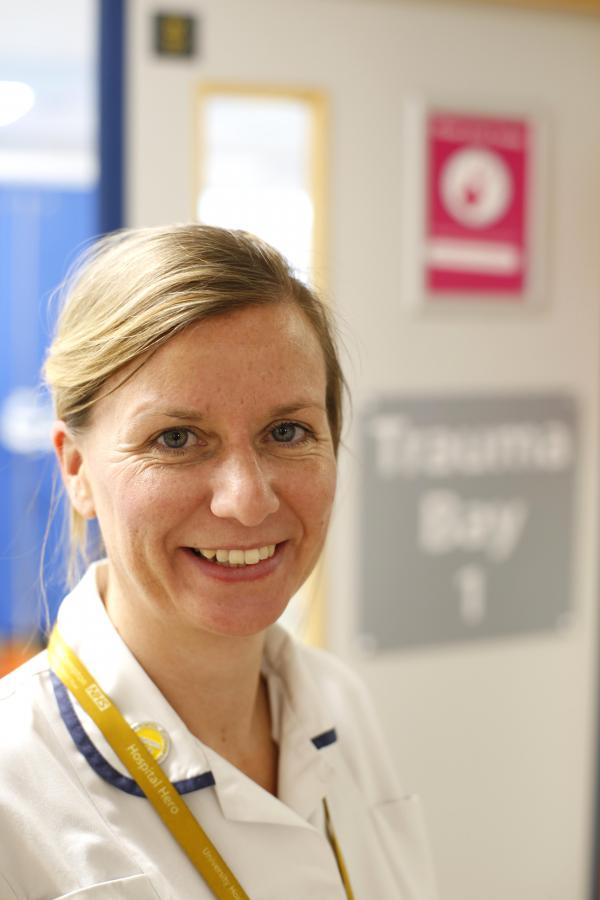How can therapists offer non-physical support to patients following major trauma?
After Southampton General Hospital became a major trauma centre in 2012, the nature and complexity of some of the physio team’s patients changed.
Specialist physiotherapist Rochelle Dunster, explains: ‘Our patients were surviving complex injuries and exceeding their probability survival score. It wasn’t just physical injuries that became more complex, but non-physical aspects too, such as grief, fear, anger, anxiety and emotional numbing.
‘So we were now being asked more complex questions like “will I ever walk again?” instead of “when will my plaster come off?”’
Her colleague, trauma lead physiotherapist Sally Sheppard, agrees: ‘Increasingly, we were finding that patients were experiencing non-physical morbidities, which weren’t being identified early on and were restricting their rehab or discharge.’
As a result, they both felt that the hospital’s approach to treating trauma patients needed to evolve.
Audit leads to change
To try to address the rising complexity of patients, Ms Sheppard and Ms Dunster audited the hospital’s major trauma and rehab service, with reference to relevant guidance from the National Institute of Health and Care Excellence (NICE).
‘The NICE guideline that we audited against, Rehabilitation following Critical Illness, advises that a functional assessment should be performed before patients are discharged,’ Mrs Sheppard says.
‘And it states that critical care patients should receive an assessment of non-physical problems such as anxiety, depression, post-traumatic stress disorder and behavioural problems.’
Anxiety and depression were identified in nearly 43% of the patients audited
Using this as a benchmark, the physios examined the notes of 40 major trauma patients who had received injuries with an index severity scale ranging from 15-41.
The results revealed that therapists had identified issues of anxiety and depression in more than a third (42.5 per cent) of patients; assessed for behavioural and cognitive issues in 55 per cent of cases; and assessed psychosocial issues, such as relationship and body image concerns, in 32.5 per cent.
But the audit also indicated that there was limited documentation about how therapists managed or escalated non-physical issues that they identified, such as anxiety and depression. And it appeared they were not delving deeper into issues by discussing mood and mental well being with patients.
‘We didn’t know if this was because therapists didn’t feel comfortable asking these difficult and sensitive questions, or because they had no way to document it,’ says Ms Dunster.
However, some issues, such as low self-esteem and body image issues, appeared to be identified and managed more effectively when an occupational therapist was involved early in a patient’s rehab journey.
The results also highlighted how easily major trauma can affect family dynamics and relationship roles, and go on to influence rehab and discharge planning.
‘As patients get closer to discharge the hidden effects of major trauma often became more apparent and these can create barriers to discharge’ Ms Dunster explains.
‘For instance, we helped rehab a man who sustained a traumatic amputation of his left arm, which required extensive plastic surgery. As his discharge date came closer, he became more and more anxious about returning home, because he had a perceived inability to fulfil the “father figure” role for his four-year-old child.
The patient, and his relatives, were very concerned about how his daughter would react to his appearance, so they decided he wouldn’t be able to return to his family home.’
Psychological issues like this, which can potentially create resistance to either rehab or discharge, could be identified much earlier on Ms Dunster believes.
‘As patients get closer to discharge the hidden effects of major trauma often became more apparent and these can create barriers to discharge’
But evidence from the audit suggested that one of the reasons non-physical effects were not being picked up sooner was because therapists were not completely confident discussing body image issues with specific patient groups, particularly amputees and people needing lower limb reconstruction or plastic surgery.
‘The results suggested that as a service we needed to improve how we identify and manage the non-physical aspects of major trauma, to improve patients engagement with rehab, prevent discharge delays and enable them to achieve their maximum potential,’ Mrs Sheppard explains.
‘Right now we have no funding for a psychology service for major trauma patients, but the results made us question whether there was anything we could do, as therapists, to improve our service and ultimately improve patients’ rehabilitation experience.’
Launching a quality improvement project
Armed with evidence from the audit, the team met with the trust’s psychology and psychiatry team to discuss how they could improve their focus on the non-physical outcomes of major trauma.
Working together, they set out to create a toolbox of resources to help therapists identify non-physical issues early on, manage onward referrals and improve patients’ engagement with rehab and discharge. They focused on PTSD, body dysmorphia, anxiety, depression, orientation and psychosocial issues.
‘We researched different outcomes measures for each condition, for example the impact of event scale for PTSD,’ says Ms Dunster.
‘And looked at different treatment aids and resources for patients, such as square breathing, mindfulness, visualisation, grounding techniques, psychological first aid, time-tabling, diaries and goal setting.’
The team also developed an initial interview, specifically for therapists to use with major trauma patients: ‘We felt that using screening tools with patients at this stage in their rehabilitation wasn’t always appropriate,’ says Mrs Sheppard.
‘So we developed a communication tool for each condition which included four or five screening questions, which help to identify and facilitate communication around these sensitive topics.’
The questions, printed on small laminated cards that fit in uniform pockets, serve as a prompt to promote beneficial discussions with patients.
‘We’ve found the communication tools really help to bring out a lot of information, as they encourage people to talk in more detail and depth, and help to feed conversations and improve rapport,’ says Mrs Sheppard.
The screening tool includes 4-5 questions to help communication around sensitive topics
As a result, therapists are now able to gain a greater insight into many of the ‘hidden’ effects of trauma that patients experience, which previously went unaddressed.
The project has also involved establishing appropriate onward referral pathways for patients – including the use of a pets as therapy service and specialist referrals to Wessex Trauma Rehabilitation Service.
‘We’ve also compiled a resource file for therapists which includes screening questions, outcome measures and treatment tools,’ she adds.
‘And resources for patients and families that include information on websites, charities, and online apps.’
Further plans include the development of orientation boxes for patients with head injuries and post-traumatic amnesia.
Going forward
The team have designed and implemented a ‘PDSA’ (plan, do, study, act) quality improvement project, to investigate the impact of the resources they have developed.
‘We are collecting data over the next few months to measure and analyse the effects,’ Mrs Sheppard says.
‘And using a patient experience survey, we’re planning to measure the prevalence of non-physical morbidities and whether therapists have been able to identify and manage those issues effectively.’
As part of the project, the therapists are now meeting weekly with psychologists from the trust to discuss patient cases, management strategies and peer support.
‘And we are collecting data on whether patients would be suitable for a referral to an in-patient psychology service, if it was available,’ she says.
Once all the data is collected, the team are hoping their findings, and any subsequent changes they make as a result, will lead to massive benefits to the service and to patients who experience major trauma.
‘If the results show our service development changes work and improve the therapists’ ability to identify and manage the hidden effects of trauma, then we hope to implement it throughout different specialities and across the Wessex Trauma Network,’ says Ms Sheppard.
Physios who would like more information about the team's findings, the service changes they introduced and their ongoing quality improvement project, can contact Sally Sheppard at: sally.sheppard1@nhs.net
Case study
Pat Long has been on the hospital’s major trauma ward since mid-January, after being admitted when she was knocked down by a car.
‘I was going swimming at half past seven one morning and I was waiting for the lights to change at the pedestrian crossing,’ she says.
‘I started to cross and thought, “that car’s a bit close”, and the next thing I remember is waking up in the ambulance.’
Mrs Long says she is making steps towards a good recovery, but it’s been a long, hard journey.
‘A lot of things the physiotherapists have shown me, for instance, square breathing, have been very useful and have helped,’ she says.
‘They take time to master, but I’m getting there slowly.’
Author: Robert Millett
Number of subscribers: 2







